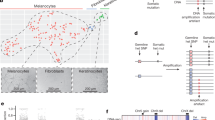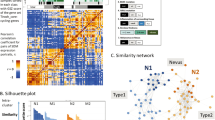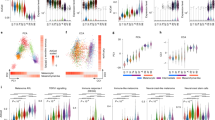Abstract
In order to improve the characterization of human malignant melanoma cells and their variant gene expression in vitro, a search for specifically regulated genes was performed. Four melanoma cell lines (M5, MEWO, IGR39, SKMEL13) and newly cultured normal human melanocytes were included in a comparative hybridization (differential screening) of a human melanoma cDNA-library. Six cDNAs were isolated showing a stronger expression (four genes) or a weaker expression (two genes) in melanoma cells than in normal human melanocytes. Quantification of the expression patterns of the two repressed genes in Northern blots revealed general expression in all melanocyte cultures examined, no expression in three cell lines (M5, IGR39, SKMEL13) and weak expression in MEWO. The four induced genes were found to be only weakly expressed in normal human melanocytes, but showed an elevated expression in all of the four melanoma cell lines tested. Thus, using the technique of differential screening, consistent gene regulation at the messenger RNA level was identified, which distinguishes the four melanoma cell lines tested from normal melanocytes. We conclude from the expression patterns that specific gene regulation in melanoma cells in vitro is characterized both by strong repression of some melanocyte genes, as well as by the induction of other genes, but there was no indication of new expression of genes specific for melanoma cells. Because of the uniform induction or repression in different melanoma cell lines, it is conceivable that the cloned genes may be involved in the malignant transformation of melanocytic cells.
Similar content being viewed by others
References
Albino AP (1992) The role of oncogenes and growth factors in progressive melanoma-genesis. Pigment Cell Res Suppl 2: 199–218
Albino AP, Davis BM, Nanus DM (1991) Induction of growth factor RNA expression in human malignant melanoma: markers of transformation. Cancer Res 51: 4815–4820
Aubert C, Rouge F, Galdino JR (1980) Tumorigenicity of human malignant melanocytes in nude mice in relation to their differentiation in vitro. J Natl Cancer Inst 64: 1029–1040
Bean MA, Bloom BR, Heberman RB, Old LJ, Oettgen HF, Klein G, Terry WD (1975) Cell-mediated cytotoxicity for bladder carcinoma: evaluation of a workshop. Cancer Res 35: 2902–2913
Bordoni R, Fine R, Murray D, Richmond A (1990) Characterization of the role of melanoma growth stimulatory activity (MGSA) in the growth of normal melanocytes, nevocytes, and malignant melanocytes. J Cell Biochem 44: 207–219
Bussemakers MJ, Ven WJ van de, Debruyne FM, Schalken JA (1991) Identification of high mobility group protein I(Y) as potential progression marker for prostate cancer by differential hybridization analysis. Cancer Res 51: 606–611
Chen L, O'Bryan JP, Smith HS, Liu E (1990) Overexpression of matrix Gla protein mRNA in malignant human breast cells: isolation by differential cDNA hybridization. Oncogene 5: 1391–1395
Danik M, Chabot JG, Mercier C, Benabid AL, Chauvin C, Quirion R, Suh M (1991) Human gliomas and epileptic foci express high levels of a mRNA related to rat testicular sulfated glycoprotein 2, a purported marker of cell death. Proc Natl Acad Sci USA 88: 8577–8581
Devereux J, Haeberli P, Smithies O (1984) A comprehensive set of sequence analysis programs for the VAX. Nucleic Acids Res 12: 387–395
Eberle J, Garbe C, Kroumpouzos G, Orfanos CE (1995) Protein patterns of benign and malignant human melanocytes show consistent changes in gene expression. Recent Results Cancer Res 139: 123–135
Eisinger M, Marco O (1982) Selective proliferation of normal human melanocytes in vitro in the presence of phorbol ester and cholera toxin. Proc Natl Acad Sci USA 79: 2018–2022
Feinberg AP, Vogelstein B (1983) A technique for radiolabeling DNA restriction endonuclease fragments to high specific activity. Anal Biochem J 132: 6–13
Giallongo A, Feo S, Moore R, Croce CM, Showe LC (1986) Molecular cloning and nucleotide sequence of a full-length cDNA for human alpha enolase. Proc Natl Acad Sci USA 83: 6741–6745
Holzmann B, Bröcker EB, Lehmann JM, Ruiter DJ, Sorg C, Riethmüller C, Johnson JP (1987) Tumor progression in human malignant melanoma: five stages defined by their antigenic phenotypes. Int J Cancer 39: 466–471
Hotta H, Ross AH, Huebner K, Isobe M, Wendeborn S, Chao MV, Ricciardi RP, Tsujimoto Y, Croce CM, Koprowski H (1988) Molecular cloning and characterization of an antigen associated with early stages of melanoma tumor progression. Cancer Res 48: 2955–2956
Houghton AN, Eisinger M, Albino AP, Cairncross JG, Old LJ (1982) Surface antigens of melanocytes and melanomas. Markers of melanocyte differentation and melanoma subsets. J Exp Med 156: 1755–1766
Hutchins JT, Deans RJ, Mitchell MS, Uchiyama C, Kan-Mitchell J (1991) Novel gene sequences expressed by human melanoma cells identified by human melanoma cells identified by molecular subtraction. Cancer Res 51: 1418–1425
Johnson JP, Stade BG, Holzmann B, Schwäble W, Riethmüller G (1989) De novo expression of intercellular adhesion molecule 1 in melanoma correltes with increased risk of metastasis. Proc Natl Acad Sci USA 86: 641–644
Krasagakis K, Garbe C, Krüger S, and Orfanos CE (1991) Effects of interferons on cultured human melanocytes in vitro: interferon-beta but not -alpha or -gamma inhibits proliferation and all interferons significantly modulate the cell phenotype. J Invest Dermatol 97: 364–372
Lee MG, Lewis SA, Wilde CD, Cowan NJ (1983) Evolutionary history of a multigene family: an expressed human beta-tubulin gene and three processed pseudogenes. Cell 33: 477–487
Lehmann JM, Riethmuller G, Johnson JP (1989) MUC18, a marker of tumor progression in human melanoma, shows sequence similarity to the neural cell adhesion molecules of the immunoglobulin superfamily. Proc Natl Acad Sci USA 86: 9891–9895
Leyva A, Kraal I, Lankelma J, Delamarre JFM, Pinedo HM (1983) High uridine phosphorylase activity in human melanoma tumor. Anticancer Res 3: 227–232
Livingston PO, Albino AP, Chung TJC, Real FX, Houghton AN, Oettgen HF, Old LJ (1985) Serological response of melanoma patients to vaccines prepared from VSV lysates of autologous and allogeneic cultured melanoma cells. Cancer Res 55: 713–720
McKenzie RC, Harley CB, Matic S, Sauder DN (1990) Fetal bovine serum contains an inhibitor of interleukin-1. J Immunol Methods 133: 99–105
Rodeck U, Melber K, Kath R, Menssen HD, Varello M, Atkinson B, Herlyn M (1991) Constitutive expression of multiple growth factor genes by melanoma cells but not normal melanocytes. J Invest Dermatol 97: 20–26
Rose TM, Plowman GD, Teplow DB, Dreyer WJ, Hellstrom KE, Brown JP (1986) Primary structure of the human melanoma-associated antigen p97 (melanotransferrin) deduced from the mRNA sequence. Proc Natl Acad Sci USA 83: 1261–1265
Sambrook J, Fritsch EF, Maniatis T (1989) Molecular cloning, 2nd edn. Cold Spring Harbor, New York
Schrier PI (1992) Melanoma genetics and cytogenetics. Clin Dermatol 10: 31–39
Short JM, Fernandez JM, Sorge JA, Huse WD (1988) Lambda ZAP: a bacteriophage lambda expression vector with in-vivo excision properties. Nucleic Acids Res 16: 7583–7600
Todaro GJ, Fryling C, De Largo JE (1980) Transforming growth factors produced by certain human cells: polypeptides that interact with epidermal growth factor receptors. Proc Natl Acad Sci USA 77: 5258–5262
Van't Veer LJ, Burgering BMT, Versteeg R, Boot AJM, Ruiter DJ, Osanto S, Schrier PI, Bos JL (1989) N-ras mutations in human cutaneous melanoma on sun-exposed body sites. Mol Cell Biol 9: 3114–3116
Versteeg R, Noordermeer IA, Krüse-Wolters KM, Ruiter DJ, Schrier PI (1988) C-myc downregulates class I HLA expression in human melanomas. EMBO J 170: 621–635
Volkenandt M, Schlegel U, Nanus DM, Albino AP (1991) Mutational analysis of the human p53 gene in malignant melanoma. Pigment Cell Res 4: 35–40
Author information
Authors and Affiliations
Rights and permissions
About this article
Cite this article
Eberle, J., Garbe, C. & Orfanos, C.E. Identification of genes specifically regulated in human melanoma cells. Arch Dermatol Res 287, 421–427 (1995). https://doi.org/10.1007/BF00373422
Received:
Accepted:
Issue Date:
DOI: https://doi.org/10.1007/BF00373422




